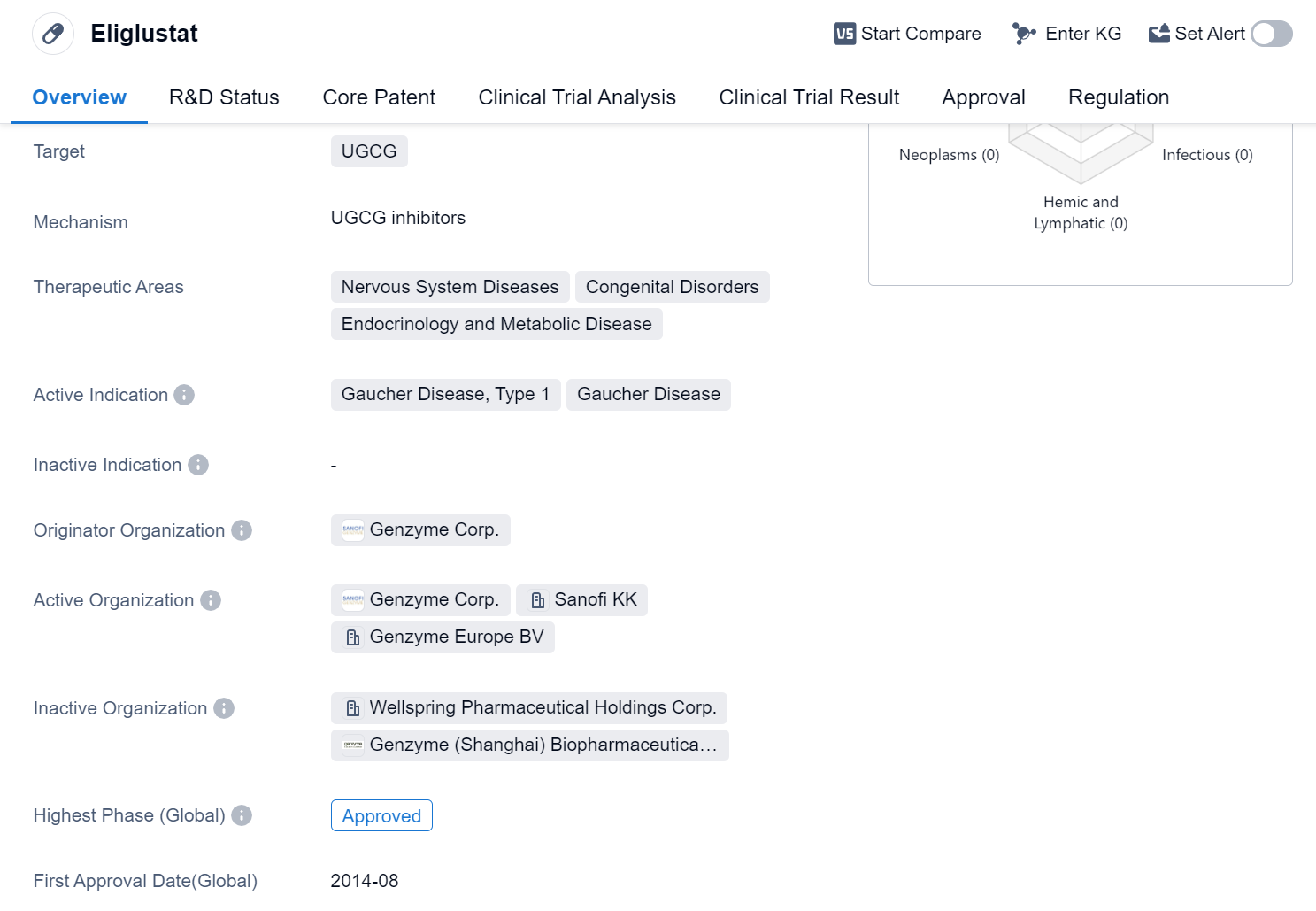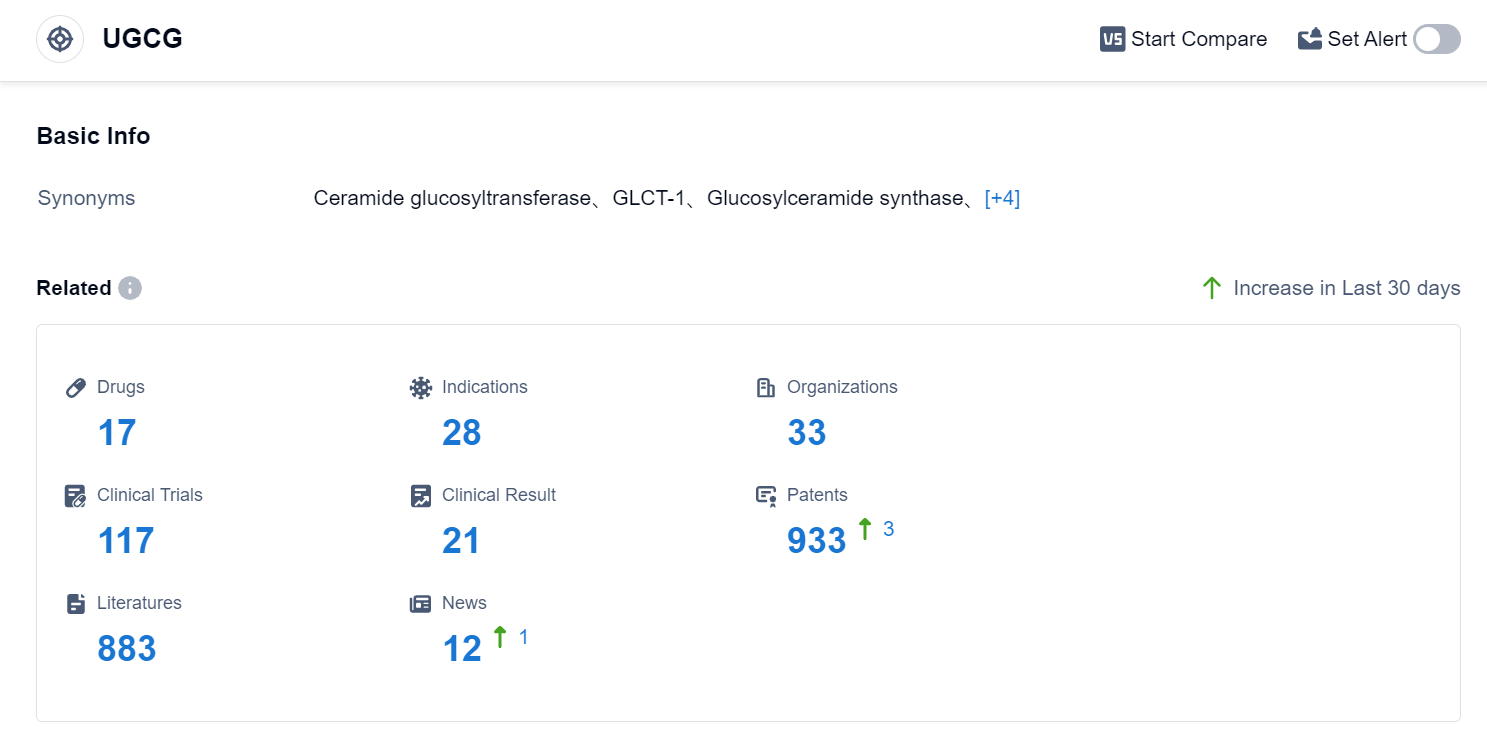A Comprehensive Review of Eliglustat's R&D Innovations and Drug Target Mechanism
Eliglustat's R&D Progress
Eliglustat is a small molecule drug that targets the enzyme UGCG. It is primarily used in the treatment of Gaucher Disease, specifically Type 1 Gaucher Disease. Gaucher Disease is a rare genetic disorder that affects the body's ability to break down a certain type of fat called glucocerebroside. This leads to a buildup of this fat in various organs and tissues, causing a range of symptoms including enlarged liver and spleen, anemia, and bone problems.
The drug was developed by Genzyme Corp., a pharmaceutical company specializing in rare diseases. Eliglustat received its first approval in the United States in August 2014, making it available for use in the treatment of Gaucher Disease. It is classified as an orphan drug, which means it is intended to treat rare diseases that affect fewer than 200,000 people in the United States.
Eliglustat is currently in the highest phase of development, which is approved globally. However, its highest phase in China is still pending, indicating that it has not yet received approval for use in the Chinese market. This suggests that the drug may still be undergoing regulatory processes in China before it can be made available to patients.
In terms of therapeutic areas, Eliglustat is primarily used in the treatment of nervous system diseases, congenital disorders, and endocrinology and metabolic diseases. These therapeutic areas encompass a wide range of conditions and disorders, highlighting the potential versatility of this drug in treating various medical conditions.
From a regulatory standpoint, Eliglustat falls under the category of overseas new drugs urgently needed in clinical settings and is also classified as an orphan drug. This indicates that there is a high demand for this drug in clinical practice, particularly for patients with rare diseases such as Gaucher Disease.
👇Please click on the image below to directly access the latest data (R&D Status | Core Patent | Clinical Trial | Approval status in Global countries) of this drug.
Mechanism of Action for Eliglustat: UGCG inhibitors
UGCG inhibitors are a type of drugs that specifically target and inhibit the activity of the enzyme called UDP-glucose ceramide glucosyltransferase (UGCG). UGCG is an important enzyme involved in the synthesis of glycosphingolipids, which are essential components of cell membranes. By inhibiting UGCG, these inhibitors can disrupt the production of glycosphingolipids, leading to various biological effects.
From a biomedical perspective, UGCG inhibitors have shown potential in cancer research and therapy. Glycosphingolipids have been implicated in cancer progression and metastasis, and inhibiting UGCG can interfere with these processes. By blocking UGCG activity, UGCG inhibitors may inhibit tumor growth, induce apoptosis (programmed cell death) in cancer cells, and potentially enhance the effectiveness of other anticancer treatments.
Moreover, UGCG inhibitors have also been explored as potential therapeutics for other diseases, such as neurodegenerative disorders and metabolic diseases. Inhibition of UGCG can impact the metabolism and function of glycosphingolipids in the nervous system and other tissues, offering potential therapeutic benefits.
It is important to note that UGCG inhibitors are still under investigation and development, and their clinical applications are yet to be fully realized. Further research is needed to understand their efficacy, safety, and potential side effects before they can be widely used in medical practice.
Drug Target R&D Trends for Eliglustat
According to Patsnap Synapse, as of 4 Sep 2023, there are a total of 17 UGCG drugs worldwide, from 33 organizations, covering 28 indications, and conducting 117 clinical trials.
The current competitive landscape of target UGCG shows that Sanofi is the leading company with drugs in the highest stage of development. Several companies are actively involved in the development of drugs targeting UGCG, with a focus on indications such as Gaucher Disease, Niemann-Pick Disease, Fabry Disease, and Polycystic Kidney Diseases. Small molecule drugs are the most rapidly progressing drug type under this target. The United States, European Union, and Japan are the leading countries in terms of drug development, with the United States having the highest number of drugs in various stages of development. While there is some progress in China, it is not as significant as in other countries. The future development of target UGCG is expected to continue with a focus on these indications and drug types, with potential for increased competition and advancements in research and development.
👇Please click on the picture link below for free registration or log in directly if you have a freemium account, you can browse the latest research progress on drugs, indications, organizations, clinical trials, clinical results, and drug patents related to this target
Conclusion
In summary, Eliglustat is a small molecule drug developed by Genzyme Corp. for the treatment of Gaucher Disease. It targets the enzyme UGCG and has received approval in the United States. While it is in the highest phase of development globally, its approval in China is still pending. The drug is primarily used in the treatment of nervous system diseases, congenital disorders, and endocrinology and metabolic diseases. Its regulatory status as an overseas new drug urgently needed in clinical settings and an orphan drug highlights its importance in addressing the unmet medical needs of patients with rare diseases.






